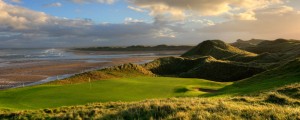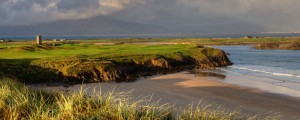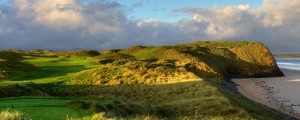Tralee GC Course Review
Whenever I’m visiting a club I’ve not been to before, especially an old one, I enjoy strolling around the clubhouse and just soaking up the atmosphere. I like the welcome area displays that show off a club’s history, with a few record scorecards and famous club trophies, with the odd coincidence or impressive feat recorded for posterity. For me, it all adds to the experience you savour as a visitor. My first few minutes at Tralee GC were spent doing just this, but while there was plenty to indulge my golfing curiosity, it was the television screen scrolling through breathtaking panoramas of the golf course that really got me itching to tee it up.
 To describe the course as photogenic would be a gross understatement. Here you can stand atop mountainous dunes and look out across Banna Strand to the Atlantic Ocean, and let your eyes roam over the undulating fairways and trace the spectacular holes that meander through the natural links land. Perhaps it helped that I caught Tralee on a gorgeous late summer afternoon, but it’s no exaggeration to say that the course afforded the best views I’ve ever witnessed on a golf course. I’ll concede that for nostalgia it’s tough to beat playing the last few holes towards the town at St. Andrews, but for sheer spectacular scenery, I don’t think anything I’ve seen comes close to Tralee.
To describe the course as photogenic would be a gross understatement. Here you can stand atop mountainous dunes and look out across Banna Strand to the Atlantic Ocean, and let your eyes roam over the undulating fairways and trace the spectacular holes that meander through the natural links land. Perhaps it helped that I caught Tralee on a gorgeous late summer afternoon, but it’s no exaggeration to say that the course afforded the best views I’ve ever witnessed on a golf course. I’ll concede that for nostalgia it’s tough to beat playing the last few holes towards the town at St. Andrews, but for sheer spectacular scenery, I don’t think anything I’ve seen comes close to Tralee.
As for the Arnold Palmer designed course, it lived up to expectations, and then some. While the back nine is rightly famed for its rugged beauty and breathtaking holes, I was already smitten by then, wooed by some superb holes on the outward nine. The reputation of the back nine (so good is it that Palmer was memorably quoted as saying: “I may have designed the first nine, but surely God designed the back nine”) has somewhat overshadowed the jewels on the front. In their own right they are good enough that, picked up and dropped anywhere else in the world, they’d by renowned as a world-class stretch of links in their own right. They only thing they suffer is proximity to an even better nine holes. And you’ll always get to those, so don’t be in too much of a hurry and just appreciate the quality of the outward loop in its own right.
It’s easy to see why Tralee sits comfortably amongst the best courses in Europe, if not the world. Quite simply, if you’re in the western half of Ireland, you have to play it.
Front Nine
The course impresses quickly at Tralee, with the par four 1st demanding you work hard for a par, though it can still fairly be described as a ‘gentle’ opener. Reaching the green, a glance back towards the clubhouse allows you to appreciate the change in elevation from your approach shot to the green.
 If evidence were needed that the front nine at Tralee is going to offer something very special, you don’t have to wait long. The par 5 second is a spectacular, sweeping coast-hugger that requires shots into three different wind directions, each one demanding precision and concentration – not easy given the first grand view of the rugged Atlantic coastline.
If evidence were needed that the front nine at Tralee is going to offer something very special, you don’t have to wait long. The par 5 second is a spectacular, sweeping coast-hugger that requires shots into three different wind directions, each one demanding precision and concentration – not easy given the first grand view of the rugged Atlantic coastline.
The 3rd is considered the signature hole at Tralee, a nervy par three played in close proximity to the crashing waves, with the green sited just in front of a 14th Century Castle. Not one for the faint-hearted, it’s the first of many fabulous par threes.
Holes four and five flank each other, with mirrored elevation changes and doglegs. Be careful to avoid the old stone wall running alongside the fourth fairway, though, or it’ll claim your errant ball as another victim.
The sixth hole, with its sharp dogleg, guarantees an approach from the rough (depending on how much of the corner you chew) or from the humps and hollows in a fairway that resemble moguls on a ski run. It’s classic links golf, plus it offers an opportunity of a ‘risk and reward’ tee shot. I’m sure a four is an underrated score here.
With Tralee being a loop of two nines, the par three 7th turns the corner back towards the clubhouse. Between this and the birdie opportunity on the uphill par five 9th, is the cracking par four 8th that doglegs left whilst hugging the rugged coastline. Steep dunes and a shapely fairway frame this hole perfectly, and demand prudent course management in order to earn a score. It was certainly one of my favourite holes on the course, and I’d imagine it plays as one of the toughest. Presuming you’ve earned that birdie on the 9th, a quick stop in the halfway hut should recharge you for the remaining holes.
Back Nine
The par four 10th doglegs left down towards the dunes, and I’d advise against carving your drive into the adjacent field as it’s not easy from there, trust me. Still, it’s another solid par four, and you catch a glance at the lengthy par five 11th to come. There’s a premium on accuracy here as you ascend towards the highest point of the course. It’s another scoring opportunity for sure, but even if you don’t walk off with a birdie, the view from here is reward in itself.
The 12th hole for me was the best on the course. I loved it. Not least for the chance granted on the hole before to witness the groups in front attempting to traverse the incredibly testing second shot over the daunting ravine, so you’re fully aware of what’s to come. The drive is hard enough – it’s fairly obvious where to go, but it’s a semi-blind shot. Having managed to get this away, I thought I’d be left with a fairly straightforward short or medium iron to the putting surface, but was somewhat dismayed to find I actually had a huge carry that was going to test my abilities from a hanging lie with a fairway wood. No bail out area (unless you count a ‘lay-up’ pitch down the fairway – and let’s face it, I didn’t come to Tralee to protect my scorecard by playing ‘pat-a-cake’ golf), just the requirement to produce a Hollywood golf shot on demand. Whatever your resulting score, it’s a very special golf hole.
From there, the par three 13th is equally spectacular, a short iron to a narrow target with punishment surrounding the green on all sides. It’s at this point that you wonder how the course can get any better, but the final loop of holes continues to impress.
The 14th and 15th are two picturesque par four’s that seem to be play in relative calmness (perhaps due to their location near a small inlet), the latter requiring a careful tee shot played to a plateaux fairway and a controlled approach to a well guarded green.
 The course then crescendos in elevation, drama, and quality of view over the par three 16th and par four 17th. Two world-class holes and two more candidates for my favourite on the course. The gentle par five 18th offers another good birdie chance, and is a fitting end to the most fantastic round of golf.
The course then crescendos in elevation, drama, and quality of view over the par three 16th and par four 17th. Two world-class holes and two more candidates for my favourite on the course. The gentle par five 18th offers another good birdie chance, and is a fitting end to the most fantastic round of golf.
The most fitting end to the day however, is found upstairs in Tralee’s Golf Club Bar where the glass panelled clubhouse affords continued enjoyment of the golfing scenery. The food is great, as are the very welcoming members. Get a pint of Guinness and relive the day with your playing partners.